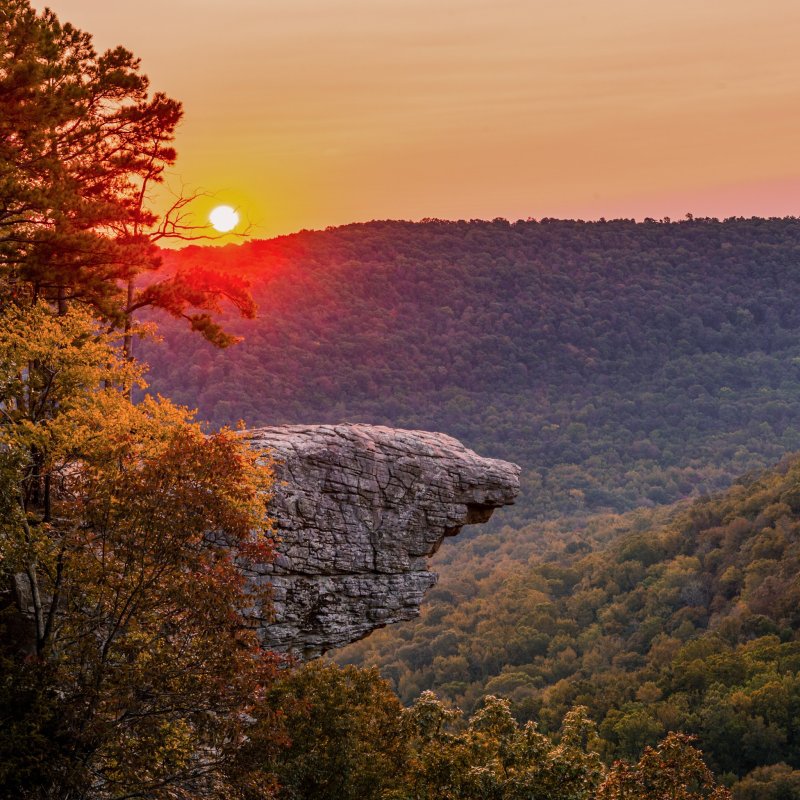
The first time I ever hiked the Buffalo River Trail in northern Arkansas was when the air was crisp with the smell of fallen leaves and a threatening cold front. Thanksgiving was just days away, and the normal lush green of the Ozark forest had muted to shades of brown and gray as trees dropped their robes. The stark limestone that juts out from these mountains was having its day in the spotlight.
Videos by TravelAwaits
Even in the November chill, I had to remove my jacket. Winter had yet to take hold here on this 36-mile through trail, and the fall sun was warm enough to hike in only a light long-sleeve shirt. I saw deer startle and prance daintily through the bare trees at the sound of my footsteps, and through the naked branches, it seemed I could see for miles.
Fall and winter are among my favorite times to hike, and in the Arkansas Ozarks, it could be the best time to hike overall. Summer in Arkansas can be steamy and heavy with humid heat, and the ticks march for blood like an army in the high heat of June and July.
While most crowds battle the heat, biting insects, and the crowds of the summer high season, I prefer the relative quietness of hiking when the weather has a slight bite of cold. Not only do you not get overheated as quickly as you would in summer, but the bare trees offer up glimpses of a landscape that is normally hidden by leaves.
Arkansas is among my favorite places to hike as well. I have long considered Arkansas to be a wildly underrated state when it comes to beauty, and my favorite part of the state is the north-central area that nestles along the Buffalo River, America’s first national river.
If you are winding your way through the snaky mountain roads of the Arkansas Ozarks this fall and winter, here are some of the best fall and winter hikes to experience in the Ozarks.

1. The Buffalo River Trail
By far my favorite trail I’ve hiked so far, the Buffalo River Trail is a 36-mile path that skirts along the Buffalo River from Ponca in Boxley Valley to Pruitt. It weaves along the towering limestone bluffs that make this river such a natural beauty, up and down the rolling mountains, and even through historic homesteads with lots of accessible campgrounds in between.
Luckily, you don’t have to hike all 36 miles to enjoy the BRT, as it’s called. Trailheads for day hikes can be accessed at numerous locations, including the south end of Boxley Valley, the Ponca Low-Water Bridge, Steel Creek, Kyles Landing, Erbie, Ozark, and Pruitt.
The trail is an unpaved, sometimes rocky path with some pretty hefty elevation changes. The trail can be broken up into manageable day hikes, but the hardest and steepest part of the trail is between Boxley Valley and Erbie. If you don’t mind the strenuous hills, you will be rewarded with spectacular views of the bluffs and the river.
There’s a nice short hike on the Buffalo River Trail between the Ponca Low-Water Bridge and Steel Creek Campground, which has a towering view of the river from atop a bluff. This two-mile one-way hike does have some elevation, but it is among the prettiest legs of the trip.
If you do hike back the way you came, a short jaunt along the old road at the Ponca Low-Water Bridge to the Beaver Jim Villines cabin is an easy and pleasant detour for when you get back.
To get to the trailhead in Ponca, turn left (south) at the intersection of Highway 21 and travel through Boxley Valley for 2.5 miles. The trailhead is on the right side of Highway 21.
Pro Tip: You’ll need to pack in your own water unless you have a water purification system in your backpack.
In the past, I would arrange the day hikes by being dropped off at one campground, for example, Steel Creek and hiking to Kyle’s Landing, where my friend would fish all day and be able to pick me up. If you don’t have someone who can pick you up, shuttle services are available that you can be arranged ahead of time. I recommend Buffalo River Outdoors, which can provide a shuttle for $30, plus a waterproof map of the trail.

2. Lost Valley, Boxley Valley
The Lost Valley hike in the heart of Boxley Valley is an easy to moderate hike that is wildly popular with tourists and locals alike. It’s easy to see why.
The Lost Valley Trail is a 2.4-mile round trip path that usually takes about 2 hours to complete, and you’ll start the hike in the parking lot. You’ll pass up through the box canyon where wildlife like deer are abundant until you reach a magical little pool of water with an 8-foot waterfall, known as the Natural Bridge.
From the Natural Bridge, you will hike up some stone steps along the Clark Creek to the Cob Cave, a large 200-foot bluff shelter.
For a truly awe-inspiring experience, take a spur trail from Cob Cave to see Eden Falls, a 53-foot waterfall that ends in a beautiful pool of blue water. Just note that this path is more rugged than the main trail.
While you can find resting benches along the main trail, the path to the top of Eden Falls is extremely steep and somewhat risky, so be cautious if you’re considering going to the top.
One of the favorite secret gems of his hike is located on the trail past Eden Falls that goes along a bluff line to Eden Falls Cave, which has its own 25-foot waterfall inside. While not extreme, you will have to do some bending and climbing and will need a flashlight to view the waterfall in the cave.
Pro Tip: When you are done exploring the cave, stay to the right each time you hit an intersection as you go back down the main trail. It’s the most direct route back. Also, parts of the trail have steep ledges and drop-offs, so use extreme caution when hiking or climbing.

3. Hemmed-In Hollow Falls
If you have a full day to spend hiking, Hemmed-In Hollow Falls is a 5-mile trail that travels 1,400 feet down. While you’ll experience the amazing scenic views of the Buffalo River and the 210-foot Hemmed-In Hollow falls (which only flows after a lot of rain), it’s not an easy hike to embark on.
The trail is extremely strenuous and steep in places, and you’ll need to carry a map in order not to accidentally go off on one of the many spur trails, but the rough wilderness has some of the best views of the Ozark Mountains and the river.
You’ll need to plan a whole day for this hike, which starts at the Compton Trailhead, located on a dirt road across from the Compton Post Office. Once you are at the trailhead parking area, the trail to Hemmed-In Hollow is marked by white rectangular blazes. Another trail, the Sneeds Creek Trail, also starts there but is marked with a yellow blaze.
Again, this trail should only be attempted by hikers who are experienced in map reading and who are in good physical condition due to its strenuous nature.
Pro Tip: Bring lots of food and water on this hike to help keep up your energy. If you are a waterfall buff, you’ll be thrilled to discover that Hemmed-In Hollow Falls, according to the National Park Service, is the “tallest waterfall between the Rockies and the Appalachians.”

4. Whitaker Point Trail, Also Known As Hawksbill Crag
Touted as “the most photographed place in Arkansas,” the Whitaker Point Trail is a 3-mile round trip path that leads to a stunning outcropping that was actually filmed as the opening scene in the Disney movie Tuck Everlasting.
It’s a heavily-trafficked trail, but the view at the end is worth the crowds, and the trail is relatively easy to moderate and well-marked with orange triangle blazes. The road up to the parking lot is fairly steep, and you might get stuck in the mud parking lot after a heavy rain, so be prepared for that.
However, once on the trail, you’ll have a pleasant stroll through the native forests. About halfway through, the trail splits to the right and left, but both directions will take you to the crag. If you go right, you’ll eventually swing left at a waterfall ledge and follow a steep bluffline to the crag. Don’t worry, you’ll absolutely know Whitaker Point when you see it, but the entire trail offers up scenic beauty and views of the valley, especially when the leaves turn gold and orange in late fall.
To access the trail, travel Highway 43 South from Ponca to Highway 21, where you’ll turn left until you cross the Boxley Bridge. From there, turn right onto Road 9560 for about 6 miles. You might feel like you’re lost, but if you see the Cave Mountain Church and Cemetery, you’re getting close.
Pro Tip: Avoid hiking on Saturday, especially in the spring and fall, when the trail is the most crowded. The parking is very limited in the parking lot, which can also get quite mucky after a rain. Also, bring extra food and water and set aside more time than you think you’ll need. Trust me. When you see Whitaker’s Point, you’ll want to linger for a while.
With so many trails in the Arkansas Ozarks, it’s hard to pick my favorite, but the ones mentioned are among the most picturesque. As with any hike, tell someone where you are going, be sure to check the weather, and know your limitations.
Stay on the designated trails, because hunting is allowed in the Buffalo River backcountry and on lands that are near to the parks and recreation areas, especially during the fall and winter. Cell phone reception is poor on many of the Ozark hiking trails, so be prepared for anything.
For more Arkansas hiking and Ozark inspiration, read up on 8 stunning hikes in Arkansas, Why beautiful Eureka Springs is the perfect fall getaway, and Ozark Mountains road trip: Osage Beach to Eureka Springs.
